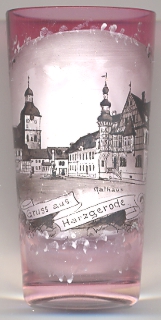

|
| DEUTSCHLAND | GERMANY |
| Bundesland: Sachsen-Anhalt | Saxony-Anhalt |
| Landkreis: Harz |
Harzgerode is situated at an elevation of 395 m in the Selke valley of the central Harz region in western Saxony-Anhalt. The municipality has a population of about 8,500 (2011) and comprises the localities Alexisbad, Bärenrode, Dankerode, Güntersberge, Harzgerode, Königerode, Mägdesprung, Neudorf, Schielo, Silberhütte, Siptenfelde and Straßberg.
 The earliest written document that mentions Hazacanroth dates from 994. The locality was founded near the Benedictine monastery Hagenrode (Alexisbad),
which in 993 obtained the market rights, and the right to mint coins and levy duties from King Otto III (996 Emperor). The right to mint coins was already lost in the 11th century.
The privileges as a town were first mentioned in 1315 and werre renewed in 1338. Güntersberge had to be ceded to Prince Georg III of Anhalt-Plötzkau by the counts of
Stolberg in 1545.
Harzgerode castle was built in 1552. From 1635 until 1709 Harzgerode was the residence of the principality
Anhalt-Harzgerode (dukes Friedrich, r.1635–1670, and Wilhelm, r.1670–1709), a collateral line of Anhalt-Bernburg.
The earliest written document that mentions Hazacanroth dates from 994. The locality was founded near the Benedictine monastery Hagenrode (Alexisbad),
which in 993 obtained the market rights, and the right to mint coins and levy duties from King Otto III (996 Emperor). The right to mint coins was already lost in the 11th century.
The privileges as a town were first mentioned in 1315 and werre renewed in 1338. Güntersberge had to be ceded to Prince Georg III of Anhalt-Plötzkau by the counts of
Stolberg in 1545.
Harzgerode castle was built in 1552. From 1635 until 1709 Harzgerode was the residence of the principality
Anhalt-Harzgerode (dukes Friedrich, r.1635–1670, and Wilhelm, r.1670–1709), a collateral line of Anhalt-Bernburg.
The  Town Hall (Rathaus) [right] on the market square is the third town hall in this place.
The first town hall was mentioned as early as 1491. This building was destroyed by a large fire in 1635 and was replaced by the second town hall in 1635.
The present building was constructed in 1900/1901 in Historicist style combining Late Medieval, Renaissance and Baroque elements.
Town Hall (Rathaus) [right] on the market square is the third town hall in this place.
The first town hall was mentioned as early as 1491. This building was destroyed by a large fire in 1635 and was replaced by the second town hall in 1635.
The present building was constructed in 1900/1901 in Historicist style combining Late Medieval, Renaissance and Baroque elements.
The  church of Sankt Marien [background left] is located east of the market square. Its tower bears the date 1523 and thus is
one of the oldest buildings in Harzgerode. The nave was rebuilt several times, especially after the large fires of 1635 and 1666. The impressive interior decorations date
from 1697–1699. The sacristy was added at the end of the 19th century. During World War II the bells were confiscated to be melted down. Only the "Seigerglocke" ('Clock Bell'),
dating originally from 1486 and recast in 1725, survived and was returned to the church after the war.
church of Sankt Marien [background left] is located east of the market square. Its tower bears the date 1523 and thus is
one of the oldest buildings in Harzgerode. The nave was rebuilt several times, especially after the large fires of 1635 and 1666. The impressive interior decorations date
from 1697–1699. The sacristy was added at the end of the 19th century. During World War II the bells were confiscated to be melted down. Only the "Seigerglocke" ('Clock Bell'),
dating originally from 1486 and recast in 1725, survived and was returned to the church after the war.
[https://de.wikipedia.org/wiki/Harzgerode, https://de.wikipedia.org/wiki/Güntersberge, http://www.harzgerode.de/verzeichnis/objekt.php?mandat=76272,
https://de.wikipedia.org/wiki/Liste_der_Kulturdenkmale_in_Harzgerode, http://www.harzgerode.de/verzeichnis/objekt.php?mandat=80729,
http://www.harzgerode.de/verzeichnis/visitenkarte.php?mandat=80745]
![[scale]](lineal.jpg)